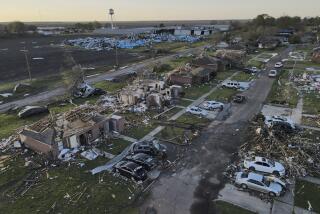As Its Poverty Ebbs, ‘Appalachia’ Expands
- Share via
Ollie Grant woke up one morning in the Delta and went to bed that night in Appalachia.
She didn’t leave Panola County, Miss., however; Appalachia came to her.
President Bush accomplished the feat this spring with a stroke of his pen, when he signed legislation adding Panola to the War on Poverty-era Appalachian Regional Commission’s territory. The county’s slogan is, “Where the hills meet the Delta.”
“You definitely ain’t hillbillies where we’re from,” says Grant, who runs an event hall in Batesville called, appropriately enough to her mind, the Delta Rose. “The city is only 219 feet above sea level.”
To many outsiders, all of Mississippi--even the hilly sections--is the Delta, and all of Kentucky--even the flat parts--is Appalachia. But what Grant and others don’t realize is that Appalachia ceased being just a geographical designation long ago.
And with the legislation, federal bureaucracy has crossed a geographical, cultural and psychological line--a border between mountaineers and flatlanders, tobacco and cotton, bluegrass and blues.
“This whole thing of what is Appalachia has been so politicized,” said Ron Eller, former head of the Appalachian Center at the University of Kentucky. “The definition of Appalachia has broadened way beyond the physical geography of the region itself.”
When Congress created the Appalachian Regional Commission in 1965, it covered 360 counties in 11 states. The territory stretched from Alabama to Pennsylvania with its core comprised of the mountainous regions of eastern Kentucky and Tennessee, and West Virginia--the only state wholly within the commission’s defined area.
Almost immediately, others hopped on the gravy train. As a senator from New York, Robert F. Kennedy succeeded in getting 13 counties in his state added later that year. In 1967, 20 mostly hilly Mississippi counties were included, along with four other counties from Alabama, New York and Tennessee.
Mississippi? That state has no mountains, the skeptics said. Wrong, said the late John Whisman, the founding father of the commission.
The state had two rather formidable peaks, he said: “Mt. Whitten and Mt. Stennis,” referring to Rep. Jamie L. Whitten, the future chairman of the House Appropriations Committee; and Sen. John C. Stennis. (The southernmost piece in “Appalachian” Mississippi is Stennis’ home county.)
Two more counties were added in 1990 and 1991, and seven more signed on in 1998. With the addition this year of Mississippi’s Panola and Montgomery counties and two in Kentucky--decidedly less than mountainous Hart and Edmonson--the region has swollen to 410 counties spanning 200,000 square miles.
“One problem with attempting to view the region whole is that Appalachia has no agreed-upon boundaries--nothing comparable to the Mason-Dixon Line,” which clearly marks a separation between regions, John Alexander Williams writes in his just-published “Appalachia: A History.” The book will deal only with “core” areas of Georgia, Kentucky, North Carolina, Tennessee, Virginia and West Virginia.
Al Smith, ARC co-chairman in the Carter and Reagan administrations, says the region’s shape has more to do with patronage than with plate tectonics.
“A lot of those counties were blatantly political swaps,” Smith said.
Eller recalls a time when counties were asking not to be included in Appalachia, a term that “connoted poverty and violence and distress and a lot of those negative images.”
“I remember lecturing up and down the region in the 1960s, and no one wanted to be associated with Appalachia,” he said. “If you talked in West Virginia, Appalachia was in east Kentucky. If you spoke to a group in east Kentucky, they said, ‘Oh, yes. That’s over in east Tennessee somewhere.’ ”
Nowadays, the term is just as likely to evoke images of natural beauty and a bygone simplicity, Eller said. And when there’s federal money to be had, what’s in a name?
Since 1965, the word “Appalachia” has meant more than $8 billion in additional federal spending to member counties--almost $5.5 billion of it for isolation-busting highways. This year, Congress reauthorized the agency for an unprecedented five years, with a recommendation that funding for non-highway projects such as Internet access and entrepreneurship programs be increased by $10 million.
Back when the commission’s map was being drawn, Rockbridge County in southwest Virginia was reluctant to take part. With its horse farms and Civil War connections, it felt more like the Shenandoah Valley than Butcher Hollow, said David Kleppinger, executive director of the Rockbridge Partnership, a local economic development agency.
Rockbridge was one of the counties added to the region in 1998. Now that he’s looking for money to build a regional sewage treatment plant to keep a local textile operation, Kleppinger doesn’t consider the change “a stigmatizing event.”
“It’s a different time,” he said. “And a different place.”
Meanwhile, in Kentucky, little Nicholas County’s pleas to join the commission have yet to bear fruit.
The county of 7,000 residents just east of Lexington’s bluegrass country recently lost a sewing plant and 326 jobs. Mayor Ronnie Clark says he’d gladly put up with a little ribbing if it meant money for sewerage or an expanded industrial park.
Amy Glasmeier, a former John D. Whisman Appalachian Regional Scholar at Penn State, has studied Appalachia’s ebbs and flows over the years. She says the slow expansion of the commission and a static budget mean more counties are vying for pieces of the same-size pie.
“It’s funny,” she said. “They can add but they can’t subtract.”
The irony of the Delta and Appalachian regions’ overlapping--at least bureaucratically--is not lost on Glasmeier. Years ago, the two regions were similarly impoverished.
“Now they’re very far apart,” she said. “Standards of living, quality of life, levels of education, square miles of road--you name it, the Delta is still way behind.”
The Delta Regional Authority was created to address those problems. In the planning stages since Bill Clinton was governor of Arkansas, it is just now poised to spread $27 million to the 240 counties and parishes in its eight-state region. (Oddly, the DRA has adopted five other Mississippi counties and three in Alabama that were ARC turf, so they presumably could double dip.)
Now, Montgomery County, Miss., is pretty much hill country, most would agree. But Panola County--that’s another story.
“I bet it ain’t 5% of the people in Panola County know what you’re talking about if you said Appalachia,” said Tommy McCullar, a Batesville businessman. “My first cousin is the governor of our state, and I don’t think he’d even know what you’re talking about.”
McCullar owns Delta Tractor & Picker. He doesn’t anticipate a corporate name change anytime soon.
More to Read
Sign up for Essential California
The most important California stories and recommendations in your inbox every morning.
You may occasionally receive promotional content from the Los Angeles Times.













